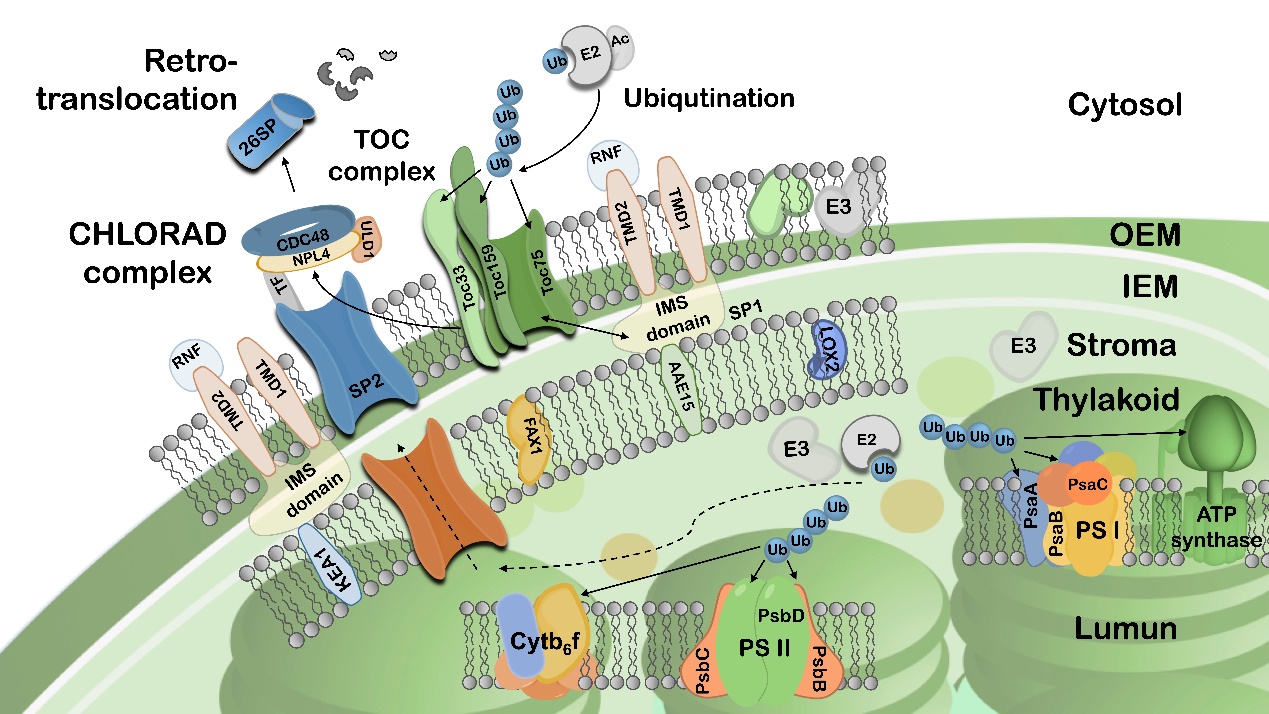Using light, photosynthesis converts carbon dioxide (CO2) into organic matter, which not only provides food for most life on Earth, but also releases oxygen and control the CO2 content in the atmosphere. In the context of achieving carbon neutrality globally, it is of great theoretical significance and application value to study the mechanism of photosynthesis. As the key organelles of plants and algae, chloroplasts perform a number of core metabolic processes, including photosynthesis. The establishment and maintenance of chloroplast functions requires precise control of its protein homeostasis (proteostasis). However, the regulatory mechanism of many key components of the photosynthetic machinery is still unknown.
Chloroplast-associated protein degradation (CHLORAD), a recently discovered pathway for the turnover of chloroplast proteins, regulates chloroplast protein transport through the ubiquitin proteasome system (UPS), and mediates plant organ development and stress resistance. In the CHLORAD system, an E3 ubiquitin ligase SP1, a channel protein SP2 and the "molecular motor" protein CDC48, jointly participate in the ubiquitination and retrotranslocation of chloroplast proteins, so that they can be degraded by the 26S proteasome in the cytoplasm. Previous results only revealed that several proteins located at the outer envelope membrane of chloroplast can be targeted by CHLORAD. However, the vast majority of chloroplast proteins are located insides the organelle, and there is no evidence whether CHLORAD can directly act on these internal substrates.
On November 16, 2022, a research paper entitled "Ubiquitination acts inside chloroplasts to directly regulate photosynthesis" was published online in the Journal Science Advances, which was completed through an international collaboration involving two research teams led by Prof Qihua Ling lab from CAS Centre for Excellence in Molecular Plant Sciences (CEMPS), and by Prof Paul Jarvis lab from University of Oxford in the United Kingdom. This study has shown that CHLORAD is responsible for the direct control of a wide range of chloroplast target proteins, including numerous proteins resident in the internal compartments, including the chloroplast inner envelope membrane, thylakoid and stroma. These proteins involve diverse aspects of chloroplast functions, ranging from photosynthesis, lipid metabolism, to stress response. This finding indicates that the reach of CHLORAD has extended to the organellar interior, which greatly expands the biological significance of CHLORAD.
Through a complementary set of approaches including ubiquitinomics, quantitative proteomics and transcriptomics, protein biochemistry, cell biology and plant physiology, the researchers have systematically revealed that various chloroplast internal proteins, including many components of the photosystems (PSI and PSII) in the thylakoid membranes are ubiquitinated. Very significantly, a number of these ubiquitin targets are encoded by the chloroplast’s own genome, indicating that the modification must happen internally. Further studies have elucidated that the retrotranslocation and degradation of these ubiquitinated photosystem proteins (such as PsaA and CP43) are mediated by the CHLORAD components CDC48 and SP2. The importance of this study lies in that it reveals a previously undiscovered proteolytic mechanism for general chloroplast proteins, as well as a new model for photosynthetic regulation.
Until now, proteins located in the chloroplast interior were thought to be regulated mainly by internal organellar proteases of prokaryotic origin (i.e., FtsH, Deg, Clp). However, this study discovered that both cytosolic and chloroplast CHLORAD components cooperate to control photosynthetic performance and other critical chloroplast functions, such as lipid metabolism. This may provide potential applications in agriculture and in delivering carbon neutrality, through plant improvement, e.g., by enhancing photosynthetic efficiency.
Dr Yi Sun from Jarvis lab and Dr Zujie Yao from Ling lab are co-first authors for this study, and Profs Qihua Ling and Paul Jarvis are co-corresponding authors. Doctoral student Yiting Ye and Dr Yuping Lyu from Ling lab, Prof Genyun Chen from CEMPS and Prof Yonghong Hu from Shanghai Chenshan Plant Science Research Center participated in the related research work. This study was funded by grants from the CAS Strategic Priority Research Program (Type-B), National Natural Science Foundation of China, and UK Research and Innovation Biotechnology and Biological Sciences Research Council (UKRI-BBSRC).
Model of photosynthetic regulation through the degradation of PSI and PSII components by CHLORAD
Article link: https://www.science.org/doi/10.1126/sciadv.abq7352
Contact:
Dr. Qihua Ling, Group leader
CAS-JIC Center of Excellence for Plant and Microbial Sciences (CEPAMS), CAS Center for Excellence in Molecular Plant Sciences (CEMPS), Chinese Academy of Sciences
Email: qhling@cemps.ac.cn
